BioShock Infinite – Hands-On Preview
- Updated: 4th Feb, 2013
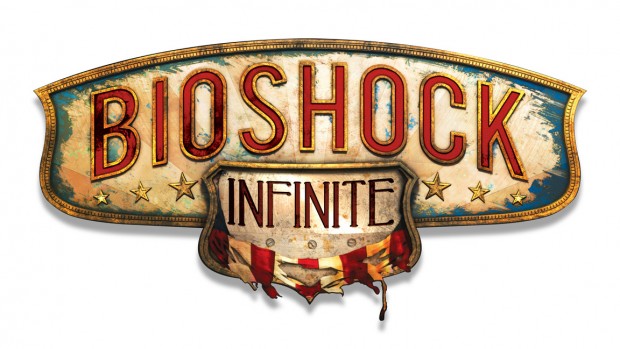
“Where am I?” asks Booker DeWitt upon his arrival at the gates of Columbia.
“Heaven, friend. Or as close as we’ll see ’til judgement day,” comes the reply from a white-clad sage dwelling in the cloud city.
Bioshock Infinite is a tale about a man, our protagonist DeWitt. It’s a tale about a self-proclaimed prophet, Father Comstock. And it’s a tale about the American Dream of the early 1900s, when good-hearted city folk lived free while the blacks and Irish stayed in their rightful place behind closed doors.
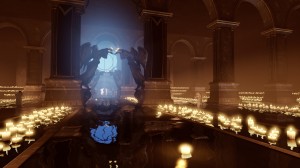 While not as heavy-hitting as Tarantino’s Django Unchained, Irrational Games has plenty to say about the US’s supremacist history through the opening carnival. Columbia is a beautiful city in which the townspeople are lounging in the streets, playing fairground games and enjoying life. The kind of place where a shopkeeper can pop out for lunch and leave his shop with just a sign to remind visitors that they’re on the honour system.
While not as heavy-hitting as Tarantino’s Django Unchained, Irrational Games has plenty to say about the US’s supremacist history through the opening carnival. Columbia is a beautiful city in which the townspeople are lounging in the streets, playing fairground games and enjoying life. The kind of place where a shopkeeper can pop out for lunch and leave his shop with just a sign to remind visitors that they’re on the honour system.
Start paying attention, however, and cracks show very quickly. Dotted about the streets are kinetoscopes, little film-playing booths with inspiring propaganda from Prophet Father Comstock, or stern warnings about how to recognise the false prophet. Find a little girl’s voxophone audio recording and you’ll hear of a mysterious “Lamb” of the city who the girl thinks must be lonely in her tower. Why the people of Columbia leave audio logs scattered about the place is anyone’s guess but it’s a tradition that survives for another 50 years in Rapture. Perhaps it’s a Steampunk version of Twitter, with people spilling their thoughts onto the street for all to hear.
The city itself is a complex set of islands that floats in the clouds above the sky, thanks to engineering genius of Dear Leader Comstock.
As DeWitt, you’re here to wipe out an unknown debt from your past by bringing Elizabeth back from Columbia. The tricky part; she’s The Lamb, precious to Father Comstock and it seems like he’s built an entire city around her. In contrast to the stiff, dead world of Rapture, this city is filled with life, especially during the carnival.
You can try your hand at shooting, test out your very own voxophone or step up up to the fairground classic High Striker to ring its bell with an oversized hammer. I spent a good 15 minutes just gawping at things, and it was gratifying to see the look of wonder on Elizabeth’s face as she did the same thing later on. Again though, things seem a little off. Why do I automatically win at High Striker? Why doesn’t anyone want money for their wares?
All around the main square are statues that seem innocuous enough until you annoy the wrong people. You’ll quickly find out that they double as turrets, conveniently placed to mow down invaders. What kind of heaven fills its public squares with machine gun turrets?
As it turns out, the machine gun turrets might well be your best friend, thanks to the first “vigor” you unlock – Possession – which temporarily converts machines, and even people, to your side.
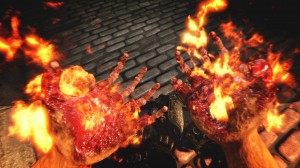 In the land of Columbia, the powers you may know as plasmids from BioShock are easily obtained by drinking potions littered about the place. There no moral quandary about juicing up here either – vigors are powered by “salt”, which you’ll find in bottles lying on street corners, on the table in bars and even free from kiosks in the street.
In the land of Columbia, the powers you may know as plasmids from BioShock are easily obtained by drinking potions littered about the place. There no moral quandary about juicing up here either – vigors are powered by “salt”, which you’ll find in bottles lying on street corners, on the table in bars and even free from kiosks in the street.
It’s strange, really, because not many others seem to wield vigors, at least not during the first three hours that I played. Why would anyone pass up such obvious advantages? This isn’t the first clue that something more than racial politics is awry in BioShock Infinite.
World-building aside, the majority of the game is a first-person shooter. You can carry two guns at any time, with 12 distinct types available – various pistols, machines guns, the excitingly-named burst gun, an RPG and more. You’ll also have eight vigors, hot-swapping between your two favourites on the d-pad with the rest easily chosen on-the-fly from a radial menu. While the gunplay is there and ammo is rarely an issue, I usually opted to toss out a quick Possession at the most rugged-looking enemy and stand back while they blew each other to pieces. The aforementioned turrets were a favourite since they’re far more durable than your typical henchman
Possessing humans does have its own dark side, however. Once the possession wears off someone, they will commit suicide. I saw no hint of a morality system within the game but watching a guard beat himself to death with his own truncheon is fairly brutal stuff. Of course, you can always walk away from the battle without even looking. You were only going to kill him anyway.
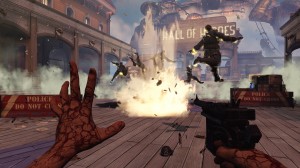 Two of the powers I unlocked were straight-up damage-dealing, while the third was called Bucking Bronco. This allows you to levitate enemies, taking them out of action for a few seconds. Devil’s Kiss shooters fire which you can, obviously, use to burn and can be gruesomely combined with the Bucking Bronco if that’s your sort of thing. A more interesting one was Murder of Crows, taken from an enemy who would burst into a flock of crows to fly around the room and reform into a human, perfectly placed to take a punch in the face from the metal skyhook in my left hand. As an added bonus, I’d already found the gear upgrade that added fire to my melee attack, to which he was conveniently vulnerable.
Two of the powers I unlocked were straight-up damage-dealing, while the third was called Bucking Bronco. This allows you to levitate enemies, taking them out of action for a few seconds. Devil’s Kiss shooters fire which you can, obviously, use to burn and can be gruesomely combined with the Bucking Bronco if that’s your sort of thing. A more interesting one was Murder of Crows, taken from an enemy who would burst into a flock of crows to fly around the room and reform into a human, perfectly placed to take a punch in the face from the metal skyhook in my left hand. As an added bonus, I’d already found the gear upgrade that added fire to my melee attack, to which he was conveniently vulnerable.
Murder of Crows allows you to send a flock of crows toward a targets, for a short damage-over-time attack that leaves them vulnerable. As with all your vigors, there’s an alternate mode that allows you to set a trap instead of choosing a specific target. As you might imagine, this is very useful for buying time while you find a safe place to stand. As a primary attack though, Murder of Crows is rather underpowered. Save it for use as a distraction.
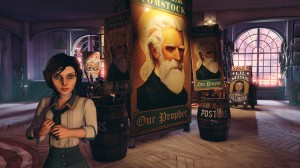 Elizabeth herself is very adept at finding safe places to hide. In fact, she’s probably the best escort mission companion ever designed. As you’re walking around the corridors, Elizabeth will occasionally find coins and pass them over to you. In battle, she may cower at the back but if your health or salts run low, she’ll be ready to toss a vial across the battlefield. All you need to do is say the word. She won’t do this on-demand though, only when you really need it.
Elizabeth herself is very adept at finding safe places to hide. In fact, she’s probably the best escort mission companion ever designed. As you’re walking around the corridors, Elizabeth will occasionally find coins and pass them over to you. In battle, she may cower at the back but if your health or salts run low, she’ll be ready to toss a vial across the battlefield. All you need to do is say the word. She won’t do this on-demand though, only when you really need it.
Should you opt to go the hard-man route and decline her help, or are simply to slow and exposed to make use of it, dying isn’t too onerous. You’ll lose a good chunk of change and both you and your surviving enemies will heal up but you can spawn in a safe space right next to the battlefield without having to re-kill any of your opponents.
Elizabeth’s unique power comes in handy during battle as well. Anyone who’s watched a BioShock Infinite trailer will Elizabeth has the ability to “tear” across realities. In many places, this allows her to bring object through from other realities, providing anachronistic gun turrets to shelter in, handy anchor points for your skyhook to grab and lots of other large problem-solving items.
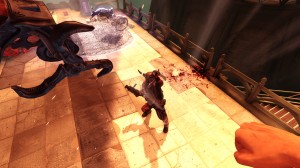 Extra skyhook anchor points during fights allow you to leap down on enemies from above, dispatching them with a quick blow to the head and, of course, more objects means more cover. Elizbeth’s power doesn’t provide the subtlest of puzzles in these early sections, the ones I saw being mostly comprised of “You are stuck. Use a tear on the big flickering thing”, but it all adds up to the big mystery – what is real?
Extra skyhook anchor points during fights allow you to leap down on enemies from above, dispatching them with a quick blow to the head and, of course, more objects means more cover. Elizbeth’s power doesn’t provide the subtlest of puzzles in these early sections, the ones I saw being mostly comprised of “You are stuck. Use a tear on the big flickering thing”, but it all adds up to the big mystery – what is real?
And that’s the crux of BioShock Infinite. From the very first second, we’re warned about tricks the mind can play. A barbershop quartet sings a familiar 60s song they can’t have known in 1912. A tear in reality opens a window to Paris circa 1983. A hot dog vendor stands idly by as you grab hot dogs from his stand and he doesn’t demand payment. What is real? Booker DeWitt may not be the most reliable of narrators. Perhaps it’s just a castle on a cloud.
BioShock Infinite will be released on 26th March 2013 for Xbox 360, PlayStation 3 and PC

Follow Us!